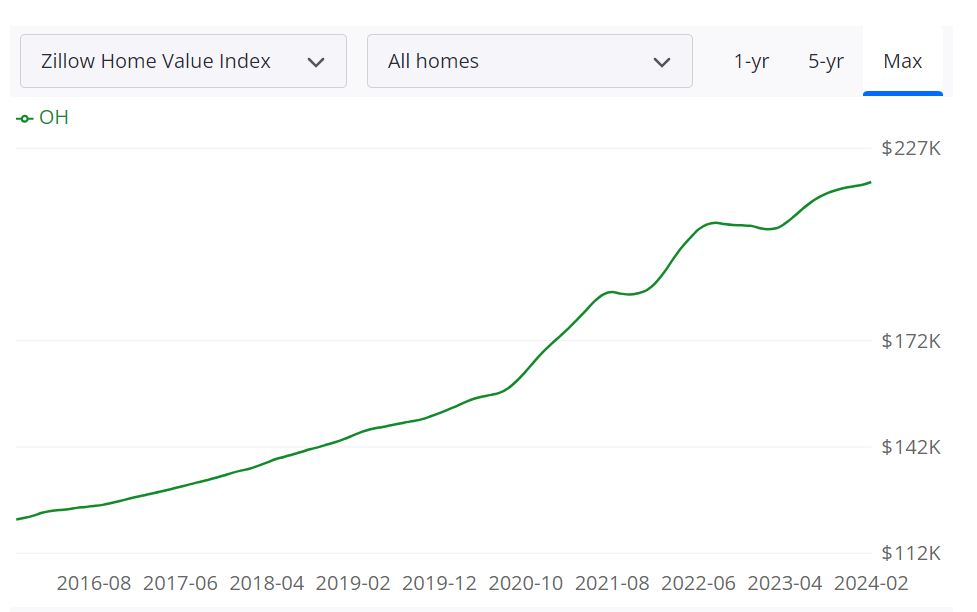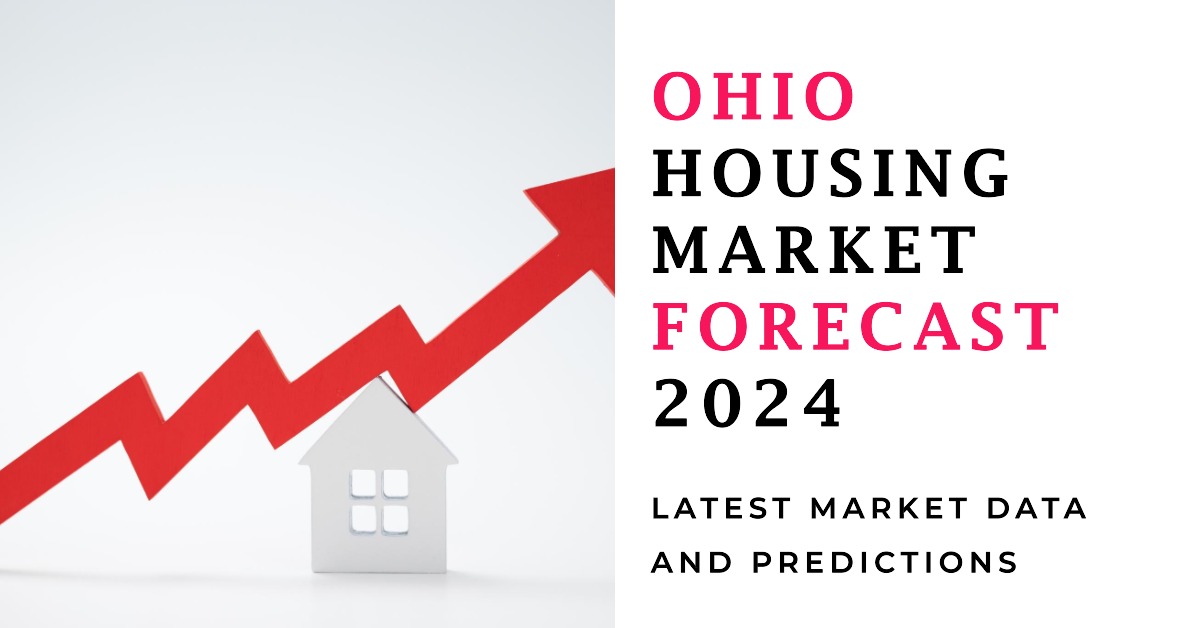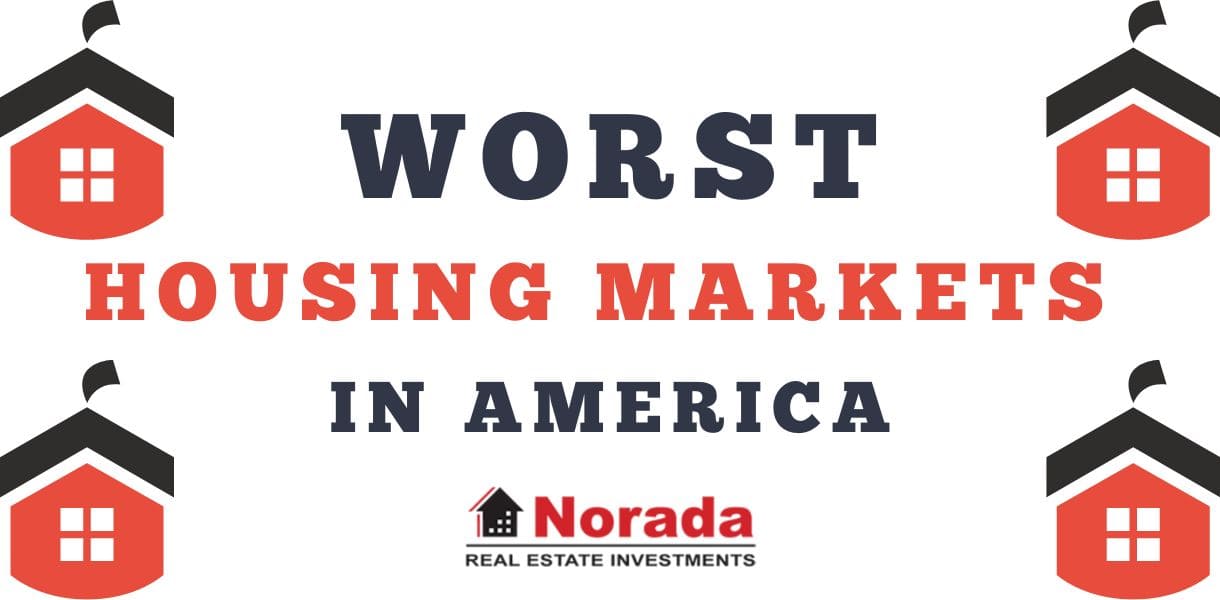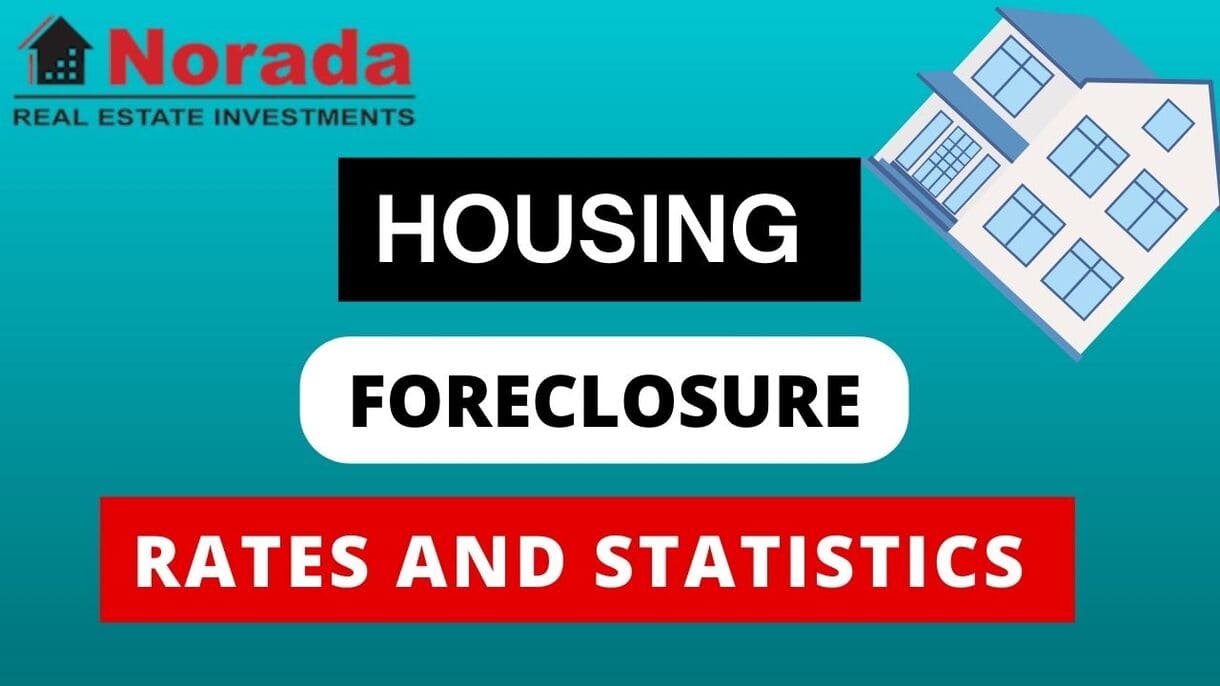The Ohio housing market in 2024 is breaking the trend of the past two years. Home sales have seen a significant uptick, marking the first increase since 2022. This positive momentum sets an optimistic tone for the real estate landscape in the state.
Ohio Housing Market Trends in 2024
Activity in the Ohio housing market has been on the rise, painting a promising picture for both buyers and sellers alike. According to Ohio REALTORS, February 2024 saw a notable surge in activity compared to the previous year. Home sales soared to 8,810, marking a robust 7.8% increase from the 8,174 homes sold in February 2023. Additionally, the average sales price across the state climbed to $264,941, reflecting an impressive 8.9% rise from the $243,210 recorded in February 2023.
Positive Trends and Market Insights in Ohio
President Ali Whitley of Ohio REALTORS expressed optimism about the recent market developments. Whitley emphasized the stabilizing interest rates and solid gains in average sale prices as key factors driving consumer confidence in homeownership. This confidence, in turn, emboldens sellers to list their properties, fostering a healthy cycle of supply and demand in the market.
Whitley highlighted the pivotal role of Ohio REALTORS in guiding both buyers and sellers through the intricacies of real estate transactions. Their expertise ensures that clients navigate the process smoothly and achieve their housing goals effectively.
Regional Insights and Growth Patterns
Across Ohio, 12 out of the 14 markets tracked witnessed an uptick in average sale prices compared to February 2023. This regional diversity underscores the broad-based nature of the market's resurgence, with various areas experiencing growth.
Examining the year-to-date figures for the first two months of 2024 reveals a sustained momentum in housing activity. Sales activity during this period surged by 6.3% compared to the same timeframe in 2023, reaching a total of 16,367 homes sold. Moreover, the average sales price for January-February 2024 stands at $259,793, representing an impressive 8.9% increase from the previous year's figure of $238,627.
Looking Ahead
As the spring home-buying season approaches, the Ohio housing market appears poised for continued growth and prosperity. With favorable economic conditions and a supportive environment for real estate transactions, stakeholders anticipate further positive outcomes in the months to come.
The recent trends in the Ohio housing market underscore a thriving ecosystem, offering opportunities for both buyers and sellers to capitalize on favorable conditions. Ohio REALTORS remain committed to guiding clients through the evolving landscape of real estate, ensuring successful outcomes and fulfilling housing aspirations.
Ohio Housing Market Forecast for 2024 and 2025
Despite record-high mortgage rates, Ohio's real estate market is still among the hottest in the country. As a result of the increased rates, buyers now have a better chance of having their offers approved, although it is still a seller's market. The market is just starting to settle down. It's not like there is a crash coming in Ohio's housing market.
Experts say there are still huge hurdles in the state's housing market, which are already hurting other issues for people seeking to find a place to live, but the demand for houses in Ohio is starting to level off, with a fall in sales and a lesser increase in the average price. Central Ohio is anchored by Columbus, the state capital and the 15th largest city in the country.
According to Zillow, the Ohio housing market is showing promising signs with an upward trend in home values. The average Ohio home value currently stands at $217,698, reflecting a 6.5% increase over the past year. Homes in Ohio are selling relatively quickly, with an average time on the market of approximately 13 days.
Understanding Housing Metrics
Let's delve into the various housing metrics to gain a comprehensive understanding of the Ohio real estate landscape:
- For Sale Inventory: As of February 29, 2024, there were 21,553 properties listed for sale in Ohio.
- New Listings: On the same date, 7,548 new listings entered the market, indicating ongoing activity and potential opportunities for buyers.
- Median Sale to List Ratio: The median sale to list ratio as of January 31, 2024, stood at 0.992. This ratio reflects the relationship between the final sale price of a home and its listing price, offering insights into negotiation dynamics.
- Median Sale Price: The median sale price of homes in Ohio, recorded on January 31, 2024, was $181,667.
- Median List Price: As of February 29, 2024, the median list price for homes in Ohio was $224,967, providing a benchmark for sellers and buyers alike.
- Percent of Sales Over List Price: Approximately 30.2% of home sales in Ohio exceeded the list price as of January 31, 2024, indicating competition in the market.
- Percent of Sales Under List Price: Conversely, 52.8% of home sales in Ohio were below the list price as of January 31, 2024, suggesting opportunities for negotiation and potential bargains.
Is Ohio a Buyer's or Seller's Housing Market?
As of the latest data analysis, Ohio's housing market presents a balanced landscape, offering opportunities for both buyers and sellers. While certain regions may lean towards one side or the other based on local factors such as inventory levels and demand, overall, Ohio can be considered a neutral market. This equilibrium provides a conducive environment for negotiations and transactions, allowing both buyers and sellers to explore their options with relative flexibility.
Are Home Prices Dropping?
As of the most recent data, there are no indications of widespread home price drops across Ohio. While certain fluctuations may occur at the local level due to various factors such as economic conditions and seasonal trends, overall, home prices in Ohio have shown resilience and stability. However, it's essential to monitor market trends closely for any shifts that may impact pricing dynamics in specific regions.
Will the Ohio Housing Market Crash?
There is currently no indication of an imminent housing market crash in Ohio. The market has demonstrated resilience and stability, with consistent growth in home values and moderate fluctuations in key indicators. However, it's essential to remain vigilant and monitor factors such as economic conditions, interest rates, and housing supply to anticipate any potential risks. While unforeseen events can impact market dynamics, Ohio's housing market appears robust and well-positioned to withstand challenges.
Is Now a Good Time to Buy a House?
For individuals considering purchasing a home in Ohio, the current market conditions present favorable opportunities. With relatively stable home prices, low mortgage rates, and a balanced market environment, now may be an advantageous time to buy a house. Additionally, waiting for market conditions to improve further or attempting to time the market perfectly can be challenging. Therefore, prospective buyers should assess their financial situation, long-term goals, and personal preferences to determine if purchasing a home aligns with their needs and objectives.

Top Areas in Ohio Poised for Home Price Growth (by Feb 2025)
When examining the potential areas in Ohio for home price growth, several regions stand out based on data analysis. These regions in Ohio offer promising prospects for home price growth, driven by a combination of factors such as economic stability, affordability, and community amenities.
- Columbus, OH: Positioned as a metropolitan statistical area (MSA), Columbus exhibits steady growth potential. From February 29, 2024, to February 28, 2025, home prices are forecasted to increase gradually, with a projected growth rate of 2.4% by the end of the period. This consistent uptrend reflects the city's robust real estate market and economic stability.
- Mansfield, OH: Similarly categorized as an MSA, Mansfield showcases positive indicators for home price appreciation. Over the same period, home prices are anticipated to rise steadily, reaching a growth rate of 2.4%. This growth underscores Mansfield's attractiveness as a desirable residential destination, supported by factors such as affordability and community amenities.
- Ashland, OH: With a projected growth rate mirroring that of Mansfield at 2.4%, Ashland emerges as another promising area for home price appreciation. The city's charm, coupled with its strategic location and access to urban conveniences, contributes to its appeal among homebuyers and investors alike.
- Van Wert, OH: Positioned as an MSA, Van Wert demonstrates potential for steady home price growth, albeit slightly lower at a projected rate of 2.3%. Despite this marginal variance, Van Wert presents opportunities for investment and residential development, driven by factors such as affordability and quality of life.
- Springfield, OH: As an MSA, Springfield showcases a positive trajectory in home price appreciation, with a projected growth rate of 2.2% by February 28, 2025. This upward trend reflects the city's resilience and attractiveness as a residential destination, supported by its diverse economy and cultural offerings.
- Bucyrus, OH: Positioned for growth, Bucyrus presents opportunities for homebuyers and investors alike. With a projected growth rate of 2.2%, Bucyrus underscores its potential as an emerging real estate market, characterized by affordability and community vibrancy.
- Wilmington, OH: Positioned as an MSA, Wilmington demonstrates a favorable outlook for home price appreciation. With a projected growth rate of 2.1% by February 28, 2025, the city presents opportunities for both homebuyers and investors seeking to capitalize on its growth potential. Factors such as economic development initiatives and quality of life amenities contribute to Wilmington's appeal.
- Zanesville, OH: Zanesville emerges as another area in Ohio showcasing positive indicators for home price growth. With a projected growth rate of 2.0%, the city presents opportunities for individuals looking to establish roots in a vibrant community with access to urban amenities and recreational offerings.
- Mount Vernon, OH: Positioned for growth, Mount Vernon presents favorable prospects for home price appreciation. With a projected growth rate of 2.0% by February 28, 2025, the city offers a blend of affordability and quality of life amenities, making it an attractive destination for homebuyers seeking value and community connectivity.
- Ashtabula, OH: Ashtabula showcases potential for home price growth, albeit at a slightly lower rate compared to other regions. With a projected growth rate of 1.9%, the city presents opportunities for investment and residential development, supported by its scenic beauty and access to recreational activities.
- Coshocton, OH: With a projected growth rate matching that of Ashtabula at 1.9%, Coshocton demonstrates potential for home price appreciation. The city's affordability and serene surroundings make it an appealing option for homebuyers seeking a tranquil yet connected lifestyle.
- Youngstown, OH: Positioned as an MSA, Youngstown rounds out the list of areas in Ohio poised for home price growth. Despite a slightly lower projected growth rate of 1.8%, the city presents opportunities for investment and residential development, buoyed by its diverse economy and cultural offerings.
- Washington Court House, OH: Positioned as an MSA, Washington Court House demonstrates a positive trajectory for home price appreciation. With a projected growth rate of 1.8% by February 28, 2025, the city offers opportunities for individuals seeking to invest in a thriving community with access to urban amenities and recreational opportunities.
- Greenville, OH: Greenville emerges as another area in Ohio poised for home price growth. With a projected growth rate of 1.7%, the city presents opportunities for both homebuyers and investors looking to capitalize on its economic stability and community vibrancy.
- Urbana, OH: Positioned for growth, Urbana showcases potential for home price appreciation. With a projected growth rate of 1.6% by February 28, 2025, the city offers a blend of affordability and quality of life amenities, making it an attractive destination for individuals and families alike.
- Cincinnati, OH: As a major metropolitan area, Cincinnati presents opportunities for home price growth. Despite a slightly lower projected growth rate of 1.5%, the city's diverse economy and cultural offerings make it an appealing option for both residents and investors seeking long-term value.
- Canton, OH: Canton demonstrates potential for home price appreciation, with a projected growth rate of 1.3%. The city's affordability and access to amenities contribute to its appeal among homebuyers and investors alike, highlighting opportunities for residential investment and development.
- Marion, OH: Marion rounds out the list of areas in Ohio poised for home price growth. With a projected growth rate matching that of Canton at 1.3%, the city presents opportunities for investment and residential development, buoyed by its community connectivity and economic resilience.
Other Factors That Can Impact the Housing Market in Ohio
When the housing market is booming, it is partly caused by job growth and decreases in unemployment. The housing market is inextricably linked to the economy. The health of the economy and job growth affects real estate buyers' purchasing power. As of Feb 2024, the unemployment rate in Ohio is 3.7%.
Before the pandemic, in 2019, Ohio's gross domestic product (GDP), the broadest measure of economic production, totaled $698.5 billion, a 3.3% increase from the 2018 total GDP of $675.9 billion. Ohio's 2019 GDP was the 7th largest in the U.S., ranked between Pennsylvania (6th) and New Jersey (8th). Ohio's real GDP grew 5.5 percent at an annual rate in the 4th quarter of 2021.
Ohio's gross state product (GSP) in 2022 reached $620.7b, with a growth of 1.0% over the 5 years to 2022. Businesses in Ohio employed a total of 5,743,338 people in 2022, with average annual employment growth over the past five years of -0.2%. The top three sectors by total employment are Manufacturing, Real Estate, Rental and Leasing, Finance, and Insurance, while the unemployment rate across the state in 2022 was 4.2%.
More people require housing as the population grows. This means that, in the long run, population growth drives increased demand for housing and, as a result, a strong real estate market. Population growth has a positive impact on the housing market. Ohio is constantly growing and according to the United States Census Bureau. The state of Ohio has a population of 11,802,444, having grown an annualized 0.2% over the five years to 2022, which ranks it 38th out of all 50 US states by growth rate.
Sources:
- https://www.ohiorealtors.org/home-sales-news-release/
- https://www.zillow.com/home-values/44/oh/
- https://fred.stlouisfed.org/series/OHSTHPI#
- https://www.neighborhoodscout.com/oh/real-estate
- https://www.ibisworld.com/united-states/economic-profiles/ohio/
- https://www.lsc.ohio.gov/documents/reference/current/ohiofacts/2020/Economy.pdf




